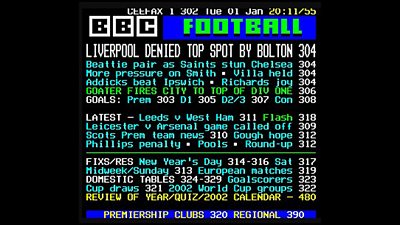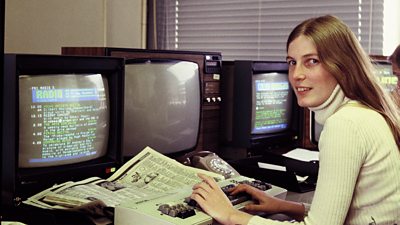Another age
Imagine a world where you could not call up the latest football results, news headlines or weather forecast whenever you want.
That was the reality of life until the mid-1970s, when Ceefax came along.
Ceefax was the internet before the internet was even thought of – the first 24/7 news service anywhere, and in its heyday it attracted more than 20 million viewers a week.
The younger generation look at you blankly if you mention it and describe its pixelated pages, but it was cutting-edge technology. As soon as you saved an updated page in the production system, the new version immediately displayed on everyoneβs TVs.
What viewers liked about the service was its immediacy and ease of use. There was no logging on to a computer or browsing on a phone to find out information β they could access it simply while they were watching TV.
The Ceefax pages could be displayed on top of the TV picture, but both News and Sport also had a breaking news page which showed just a couple of lines at the bottom of the page. If a viewer selected that page, then a news flash would appear when published, but would not cover the screen and stop them watching their favourite show. Sport also had a two-line version of its vidiprinter displaying latest football scores, which also had a full-page option.
Some viewers felt so attached to the service that they used to phone in with queries or complaints β or some of them just for a chat. In those days, the switchboard would put people straight through to relevant production teams and we had our regular callers who almost seemed to regard us as friends!
Great for football results
Before joining the ΒιΆΉΤΌΕΔ, I was a big user of the Ceefax Sport pages in the 1980s, desperately searching the football section for occasional mentions of my team Brentford to see if we had signed a player, so to work there in the 1990s was a dream come true.
I initially got work as a freelancer in 1992 and spent two years working evenings and weekends around my day job.
There was always a special buzz on a Saturday afternoon football shift β especially when you had the job of updating the latest scores pages, knowing they were being used by millions of people.
In those days, the goal flashes came through on a teleprinter and someone ripped off the piece of paper with the details and handed it over to you, before you typed out the scorerβs name and changed the match score. You felt a real sense of responsibility knowing so many people were waiting for the pages to update β whether that was in their homes or crowded outside electrical retailersβ shop windows.
I joined the staff full-time in 1994 and over the next 10 years was lucky enough to cover both major and minor sports stories and events for the service. I was also the serviceβs last sports editor and, among other things, came up with the vidiprinter idea.
Despite the huge output of stories, scores and tables which we carried, we only had a small team of eight of us working on the sports pages, which made us very close-knit.
Beating the competition

There was also the element of competition of getting the story up before our rivals on ITV Teletext. We had our headlines page on 301 up on one TV alongside theirs on another, and the adrenaline flowed when we had breaking news to report or a match report to publish. Beating them to a story always gave us a sense of satisfaction and also one of achievement, because it cemented our reputation as the place to go to find out news and scores first.
Ceefaxβs latest football scores service also made us popular visitors to the press rooms at various events when we had an outside broadcast.
I remember working at the World Snooker Championship in Sheffield in the 1990s and the players, who often used to just sit in the press room when they were not playing, crowding around our desk to find out how their football team was doing on a Saturday afternoon. We were their only source of information.
And speaking of the snooker, our latest scores pages did at times cause conflict with ΒιΆΉΤΌΕΔ TV colleagues, who sometimes showed matches βas liveβ after they happened. I once had to field a call from an angry person working on the broadcast demanding we removed our pages until the highlights had been shown. This did not happen of course!
It was not just at events we worked at where Ceefax came into its own.
For example, if you ever went into the pavilion at Lordβs cricket ground, there was a row of TVs on the wall each displaying the latest score from a different County Championship match.
Gary Lineker's Ceefax
Gary Lineker famously said in the 1990s that he would prefer to watch Wimbledon play football on Ceefax rather than on the pitch.
Ceefax also played its part in a famous FA Cup giant-killing when Wycombe Wanderers called the service asking us to put out an SOS call for a new striker. The story was seen by the agent of striker Roy Essandoh, who joined Wycombe as a result and scored the goal which beat Leicester in the quarter-finals.
Ceefax was not just sport of course, we also had teams covering news, business, entertainment, weather and more. It was also where subtitling of TV programmes started, which of course still continues today.
In 2004, all the teams merged with the fledgling ΒιΆΉΤΌΕΔ website to form one big text team for each section. I moved into a senior role on the sport website and initially a large part of my job was helping staff with the transition.
Because we now had to service audiences for both Ceefax and the website, the top four paragraphs of a web story still had to be totally self-contained. In other words, all the relevant facts β with balance β had to be in there, just as they always had been. Writers then had to write a fifth paragraph of context before expanding the story on the website. This was a skill which had to be learned but slowly and surely, everything clicked into gear.
Ceefax did not just operate in London but also had regional services all around the country.
It was a sad day in 2012 when, with the analogue system being switched off around the UK, Ceefax ended β just over 38 years after launching. The Red Button service, launched as a digital version of Ceefax, remains and now also has some of the Ceefax page numbers for familiarity.
However, Ceefax-style teletext services do still operate in several other European countries so if you are ever on holiday there you can see for yourself just what you have been missing!
Written by Ian Westbrook, ΒιΆΉΤΌΕΔ Digital Curation
-
Felicity Cowie recalls working on Ceefax from 1997 to 1999.
-
ΒιΆΉΤΌΕΔ Archives Ceefax and the birth of interactive TV
-
External site: Teletext services continue in Finland
-
External site: Live updated Ceefax pages by Nathan Dane

